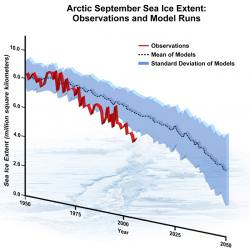The effects of global warming are already being felt worldwide, but the Earth’s poles are suffering the worst of it. Climate researchers have built a series of models to predict what impact rising temperatures will have on the amount of sea ice in the Arctic Ocean, and it appears they didn’t make these models conservative enough. Sea ice is being depleted at triple the rate that was predicted.
The research was reported in a new study by the National Center for Atmospheric Research (NCAR) and the University of Colorado’s National Snow and Ice Data Center (NSIDC). The authors compared simulations of of past climate to current observations on land and from space. The models estimated that ice would decrease at a rate of 2.5% per decade from 1953 to 2006. But the latest observations show that ice declined at an average rate of 7.8%. In other words, the decline of sea ice is currently about 30 years ahead of schedule from what researchers were originally predicting.
Several factors could have gone into the incorrect models, such as overestimating the thickness of present-day sea ice, or misunderstanding the atmospheric and oceanic circulation that transports heat to the polar regions.
Original Source: UCAR News Release

